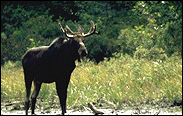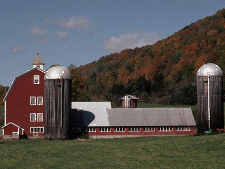Our state animal is the moose, our
state bird is the chickadee, our flower is the pine cone and tassel, our
insect the honeybee, our mineral is tourmaline, and our tree is the white
pine. So why would anyone think that a soil should be included  in such a romantic list of images symbolic of the great State of Maine?
in such a romantic list of images symbolic of the great State of Maine?
Our natural resource base depends on
the soil! A
quick review of the list of state symbols above reveals that most of these
are related to either "what we see" or "what we sell". As our population
grew over the years, so did our sense of identity, including our reliance
on the resource base, and the development of the Maine economy. So much
of our identity is involved  with our extensive forest lands in Maine, including
the wildlife and recreational resources they represent. For most
people, when we speak of Maine's "natural resources" what comes to mind
are images of crops, forests, lakes, and wildlife. Yet each and all
of these resources reflect the qualities of the soil that support them.
with our extensive forest lands in Maine, including
the wildlife and recreational resources they represent. For most
people, when we speak of Maine's "natural resources" what comes to mind
are images of crops, forests, lakes, and wildlife. Yet each and all
of these resources reflect the qualities of the soil that support them.
Soils are often overlooked
because they "do their best work" in the mystical darkness of the underground......."
out of sight, out of mind!" Soil science itself is a relatively new
science having only evolved on its own in the last 100 years. Although
people studied and managed  soils
for thousands of years before that, they usually thought of themselves
as farmers or engineers, not as soil scientists. The Chinese actually
used extensive soil maps for the purpose of taxation over 4000 years ago
since the quality of the soils on a person's land best reflected individual
wealth. We have also witnessed over the past three decades an explosion
of public concern, scientific research, and legislative debate on environmental
issues. Landfills, toxic waste sites, climate change, acid rain,
erosion, pesticide migration, ground water contamination, underground oil
tanks, lake eutrophication, wetland loss, site remediation or recycling
technologies are all examples of problems that have raised our awareness
of the turnkey role soils play in addressing modern environmental issues,
and the contributions of soil scientists in these activities.
soils
for thousands of years before that, they usually thought of themselves
as farmers or engineers, not as soil scientists. The Chinese actually
used extensive soil maps for the purpose of taxation over 4000 years ago
since the quality of the soils on a person's land best reflected individual
wealth. We have also witnessed over the past three decades an explosion
of public concern, scientific research, and legislative debate on environmental
issues. Landfills, toxic waste sites, climate change, acid rain,
erosion, pesticide migration, ground water contamination, underground oil
tanks, lake eutrophication, wetland loss, site remediation or recycling
technologies are all examples of problems that have raised our awareness
of the turnkey role soils play in addressing modern environmental issues,
and the contributions of soil scientists in these activities.
Soils are vital components of our natural
ecosystems. We identify and map the different types of soils on the
landscape, and give the different types of soil a name. Individual
soils have a scientific name and a common name, just like plants and animals.
The state tree is the eastern white pine, which has the scientific name
Pinus strobus. Likewise, our state soil will be the Chesuncook
soil series, which has the scientific name coarse-loamy, mixed,
frigid Aquic Haplorthods. Soils are "living" systems. They
are composed of particles of minerals and organic matter, some of which
are newly created as soils "weather" or form over time. Soils are complex, often having different layers or what we call soil "horizons".
Soils "breathe", consuming oxygen and releasing carbon dioxide due to microbial
activity and root respiration within them. Soils provide nutrients
for plant communities, serve as a home for numerous organisms, and control
the hydrology of the landscape as well as the quality of ground and surface
water supplies. Soils often play a critical role in buffering natural
ecosystems against pollutant impacts through filtration, transformations,
and degradation. Soils can be almost all organic matter, like the
many peat soils of Maine, or almost all mineral, like the sandy beaches
along our coast. The qualities of the soil govern the type of natural
plant communities that develop, and therefore influence the habitat available
to wildlife. If you eat food, drink water, use wood or paper, have a septic
system, care for a lawn, drive on roads, enjoy the great outdoors, or plant
flowers and shrubs around the house then you can appreciate the importance
of our soils.
Soils are complex, often having different layers or what we call soil "horizons".
Soils "breathe", consuming oxygen and releasing carbon dioxide due to microbial
activity and root respiration within them. Soils provide nutrients
for plant communities, serve as a home for numerous organisms, and control
the hydrology of the landscape as well as the quality of ground and surface
water supplies. Soils often play a critical role in buffering natural
ecosystems against pollutant impacts through filtration, transformations,
and degradation. Soils can be almost all organic matter, like the
many peat soils of Maine, or almost all mineral, like the sandy beaches
along our coast. The qualities of the soil govern the type of natural
plant communities that develop, and therefore influence the habitat available
to wildlife. If you eat food, drink water, use wood or paper, have a septic
system, care for a lawn, drive on roads, enjoy the great outdoors, or plant
flowers and shrubs around the house then you can appreciate the importance
of our soils.
![]() The
very character of the Maine landscape is a reflection of our soils.
It seems appropriate that a soil be recognized as one of our state symbols,
and that we all become more conscious of how valuable soils are, indeed
how critical they are to our "way of life". We benefit in so many
ways from our soils, but we also face significant challenges in the 21st
century in conserving this resource. Soil erosion and pollution pose
significant threats to the "sustainability" of many of our natural and
managed ecosystems. This puts at risk the legacy of abundant crops,
forests, and clean water for future generations. Lets make the Chesuncook
soil series not only serve as one of the symbols of Maine we can be proud
of, but also a symbol of our commitment to future generations. The
state soil symbolizes the commitment of Mainers to maintaining our natural
resource richness for the future, part of Maine's reputation recognized
throughout the world.
The
very character of the Maine landscape is a reflection of our soils.
It seems appropriate that a soil be recognized as one of our state symbols,
and that we all become more conscious of how valuable soils are, indeed
how critical they are to our "way of life". We benefit in so many
ways from our soils, but we also face significant challenges in the 21st
century in conserving this resource. Soil erosion and pollution pose
significant threats to the "sustainability" of many of our natural and
managed ecosystems. This puts at risk the legacy of abundant crops,
forests, and clean water for future generations. Lets make the Chesuncook
soil series not only serve as one of the symbols of Maine we can be proud
of, but also a symbol of our commitment to future generations. The
state soil symbolizes the commitment of Mainers to maintaining our natural
resource richness for the future, part of Maine's reputation recognized
throughout the world.